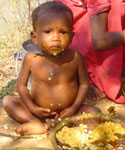A week after rising floodwaters cut off hundreds of villages in the eastern Indian state of Orissa, some 1 million people are still marooned on rooftops and trees. Swirling currents from overflowing rivers have prevented relief workers from reaching many remote villages where reports of disease have raised alarm.
In 1999, Orissa was hit by a deadly cyclone that destroyed thousands of homes. Health officials say jaundice, diarrhea and malaria are breaking out both among the stranded and those already rescued and now camping in temporary housing in schools, colleges and government buildings. At least 1,925 cases of diarrhea have been reported, a source told the Associated Press.
“It hasn’t reached epidemic proportions yet, but the danger is very much there if it carries on like this for much longer,” Krishna Chandra Mohanty, chief administrator of one of the most heavily affected districts, Kendrapara, told Agence France-Presse.
However, floodwaters continue to make the journey to remote villages dangerous, if not impossible. Two members of a health team were killed Sunday (July 22) when their boat capsized in the Bhargavi River in Puri, one of the worst hit districts in Orissa. Five members of the same team had to be rescued by a navy boat.
Ironically, as the floodwaters recede, the situation only becomes more difficult. Once the waters lower to a certain level, the boats are no longer able to function, but most roads remain impassable.
On Sunday, the death toll from the floods climbed to 55. However, unofficial sources, including local newspapers, put the number at 70. More than 8 million people in 11,000 villages have been affected by the floods, which have left millions homeless. The floods have damaged some 600,000 hectares (1.5 million acres) of cropland.
Thousands of villagers have pitched makeshift tents. Plastic sheets supported by bamboo poles line the spots that remain above water after entire villages were submerged.
Six air force helicopters continue to drop food, medicines and drinking water pouches to those who are stranded. The army has set up mobile dispensaries in badly hit areas, where residents can get water purification tablets and rehydration salts for diarrhea victims.
Although the waters of the Mahanadi are receding, other rivers are rising. –Courtesy of BBC
Red Cross relief workers also continue to deliver aid. “The priority now is to ensure that we can distribute as many water purification tablets and rehydration salts as soon as possible,” said Patrick Fuller, information officer for the International Federation of Red Cross and Red Crescent Societies. “There have certainly been incidents of gastro-enteritis and diarrhea, but no major outbreaks so far.”
Although the waters of the Mahanadi, the biggest river in Orissa, and its tributaries are receding, other rivers like the Bramhani and Baitarani are rising, causing the government, on Sunday, to warn of a new round of flooding in some districts.

